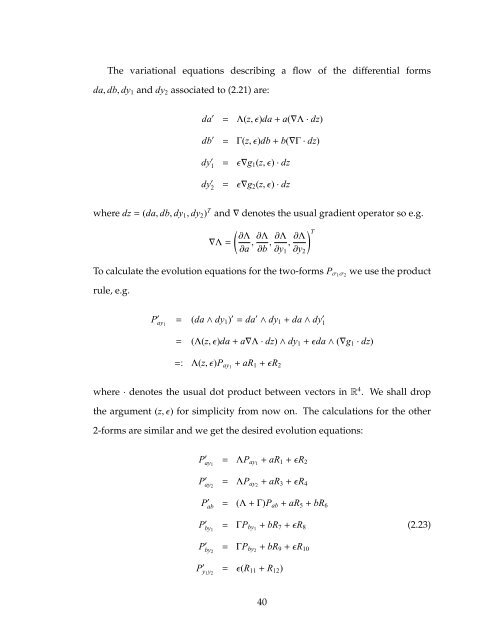multiple time scale dynamics with two fast variables and one slow ...
multiple time scale dynamics with two fast variables and one slow ...
multiple time scale dynamics with two fast variables and one slow ...
Create successful ePaper yourself
Turn your PDF publications into a flip-book with our unique Google optimized e-Paper software.
The variational equations describing a flow of the differential forms<br />
da, db, dy1 <strong>and</strong> dy2 associated to (2.21) are:<br />
da ′ = Λ(z,ǫ)da+a(∇Λ·dz)<br />
db ′ = Γ(z,ǫ)db+b(∇Γ·dz)<br />
dy ′<br />
1<br />
dy ′<br />
2<br />
= ǫ∇g1(z,ǫ)·dz<br />
= ǫ∇g2(z,ǫ)·dz<br />
where dz=(da, db, dy1, dy2) T <strong>and</strong>∇denotes the usual gradient operator so e.g.<br />
∇Λ=<br />
<br />
∂Λ<br />
∂a ,∂Λ<br />
∂b ,∂Λ,<br />
∂y1<br />
∂Λ<br />
T ∂y2<br />
To calculate the evolution equations for the <strong>two</strong>-forms Pσ1σ2 we use the product<br />
rule, e.g.<br />
P ′ ay1<br />
= (da∧dy1) ′ = da ′ ∧ dy1+ da∧dy ′<br />
1<br />
= (Λ(z,ǫ)da+a∇Λ·dz)∧dy1+ǫda∧(∇g1· dz)<br />
=: Λ(z,ǫ)Pay1+ aR1+ǫR2<br />
where·denotes the usual dot product between vectors in R 4 . We shall drop<br />
the argument (z,ǫ) for simplicity from now on. The calculations for the other<br />
2-forms are similar <strong>and</strong> we get the desired evolution equations:<br />
P ′ ay1 = ΛPay1+ aR1+ǫR2<br />
P ′ ay2 = ΛPay2+ aR3+ǫR4<br />
P ′<br />
ab = (Λ+Γ)Pab+ aR5+ bR6<br />
P ′<br />
by1 = ΓPby1+ bR7+ǫR8 (2.23)<br />
P ′<br />
by2 = ΓPby2+ bR9+ǫR10<br />
P ′ y1y2 = ǫ(R11+ R12)<br />
40
















